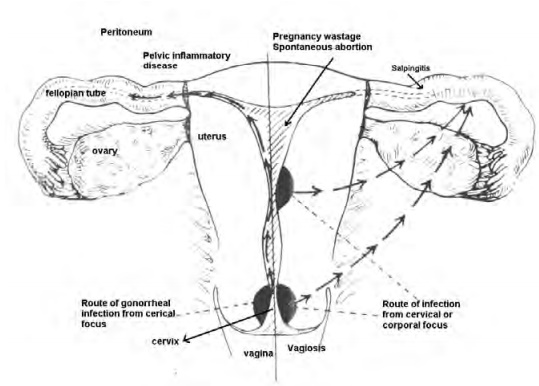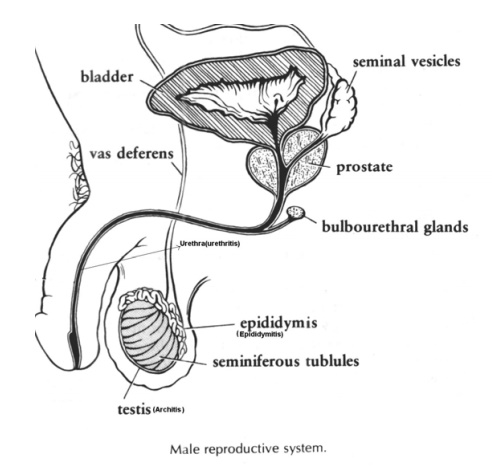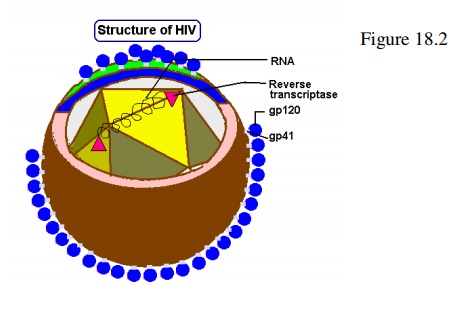Chapter: Microbiology
Sexually Transmitted Diseases

SEXUALLY TRANSMITTED DISEASES
Introduction
Sexually transmitted diseases are the most common communicable diseases after common cold. They are transmitted through sexual contact. They can be classified into the following: 1. Bacterial 2. viral 3. Parasitic 4 and fungal diseases.
Bacterial diseases
The following are some of the sexually transmitted bacterial dis-eases. 1. Syphilis 2. Gonorrhea 3.Chancroid 4. Chlamydial diseases
The sexually transmitted viral diseases are 1. AIDS 2.Hepatitis B 3.Warts.
Trichomoniasis and genital candidiasis are the parasitic and fun-gal diseases respectively.
Syphilis
Treponema pallidum is the organism that causes syphilis . Tre-ponemes are slender spirochetes with fine spirals and pointed or round ends. The pathogenic treponemes have not yet been cultivated in arti-ficial media
Pathogenesis
T.pallidum is transmitted from one partner to another through intact or damaged mucosa. The organisms establish at the point of en-trance and multiply with in the next 3 months and a chancre appears. This is the primary lesion and may disappear. This stage is called pri-mary syphilis
Secondary syphilis occurs in two to 6 months after the primarysyphilis. Because of the multiplication of the organisms secondary le-sions appear on the skin. Spirochetes are abundant in these lesions. Usually the lesions heal spontaneously.
In few cases tertiary syphilis appears later. This causes chronic granulomata known as gummata in the brain, bone, skin and internal organs. Late manifestations are degeneration of brain cells and de-struction of nerve fibres. Tertiary lesions contain few spirochetes.
Infection during pregnancy can be transmitted to the fetus. This causes congenital syphilis.
Laboratory diagnosis
Exudates from primary and secondary lesions are collected for examination. They are examined by dark field microscopy for spiro-chetes and stained by silver staining method to show the spirochetes.
Blood is collected for serological tests to demonstrate antibod-ies. Serological tests are divided into two groups viz. nonspecific and specific tests.
In the nonspecific test antibodies to cardiolipin which develop during the infection are demonstrated. The test is called VDRL test.
In the specific test, antibodies developed against T.pallidum are demonstrated. Treponema pallidum immobilization test (TPI), Fluo-rescent treponemal antibody absorption test (FTA-AB), and Treponema pallidum haemagglutination test (TPHA) are some of the specific tests used for the diagnosis of syphilis.
Penicillin is the drug of choice for treatment. For control, all dis-covered cases must be promptly treated and contacts also must be treated. Sex hygiene, and prophylaxis at the time of exposure are some other control measures. Sexually transmitted diseases can be transmit-ted simultaneously. Therefore, it is necessary to consider the possibility of syphilis when any other sexually transmitted disease is found.
Gonorrhea
Gonorrhea is a sexually transmitted infection of columnar and transitional epithelium caused by Neisseria gonorrhoeae. The urethra, endocervix, anal canal, pharynx and conjunctivae may be infected di-rectly. Systemic infection may lead to arthritis, tenosynovitis, dermati-tis, endocarditis and meningitis.
Organism
Neisseria gonorrhoeae are gram negative diplococci, kidney shaped, the concave side face each other, nonmotile. Grows on en-riched medium in presence of 5-10% CO2...
Structure of male and female genital tracts (Figure 18.1)

Pathogenesis
Anterior urethra is mainly affected in men. Anterior urethra and cervix are affected in women. In advanced infection it affects the pros-tate, seminal vesicles and epididymis in men and uterus and fallopian tubes are affected in women. Rectal infection and throat carriage occur in both. Gonococcal ophthalmia neonatorum is an infection of the eye of the newborn, is acquired during the passage through infected birth canal. The conjunctivitis progresses and if untreated results in blind-ness. To prevent this instillation of tetracycline, erythromycin or silver nitrate solution into the conjunctival sac of the new born is compulsory. Gonococcal bacteremia leads to skin lesions on the hands, fore arms, feet, and tenosynovitis and suppurative arthritis.

Laboratory diagnosis
Pus and secretions are taken from urethra, cervix, rectum, con-junctiva, throat or synovial fluid for smear and culture. Cultures are to be done immediately after the collection of specimens.
Treatment: Penicillin is given. If the organisms are resistant,after performing antimicrobial susceptibility testing, appropriate drug is given.
Chancroid
Haemophilus ducreyi causes irregular ulcers in the genitalia. It produces chancroid or soft chancre. This is a venereal disease or sexu-ally transmitted disease. H.ducreyi is a gram negative bacilli. Chan-croid is treated with sulphonamides. If resistant, erythromycin and cotrimoxazole are used.
Chlamydial disease
There are many serotypes in Chlamydia. Some of them cause genital infections.
Lymphogranuloma venereum is one of chlamydial sexually trans-mitted diseases. First a vesicle develops and the lesion ulcerates in the genitals. The inguinal lymph nodes enlarge, suppurate and release pus through multiple sinus tracts. If not treated it will lead to other compli-cations. Sulfonamides and tetracycline are used for the treatment.
Trichomoniasis
This is caused by Trichomonas vaginalis. Trichomonads are flagel-late protozoa with 3-5 anterior flagella, other organelles and an undu-lating membrane.
In female the infection is limited to vulva, vagina and cervix. It usually does not extend to uterus. The mucosal surface may be painful, inflamed, eroded and covered with a frothy yellow or cream colored discharge. In males the prostate, seminal vesicle and the urethra may be infected.
Trichomoniasis is treated with topical and systemic metronida-zole. The patients sexual partner should be examined and treated si-multaneously.
Trichomoniasis is treated with topical and systemic metronida-zole. The patients sexual partner should be examined and treated si-multaneously.
Genital candidiasis
The most common cause of genital candidiasis is due to Candida albicans. Generally it is a commensal in the vagina. When infection oc-curs white membranous patches are produced in the vagina and vulva. Thick or watery vaginal discharge is seen. Gram’s stain can identify the yeast like cells. Nystatin or miconazole or ketoconazole are used.
Viral agents
AIDS (Acquired immunodeficiency syndrome)
Human Immunodeficiency Virus (HIV) is the etiologic agent of AIDS. It belongs to the lenti virus sub group which includes slow viruses.
The virus has central nucleoprotein core that contains single stranded RNA genome. The enzyme reverse transcriptase is associ-ated with the viral RNA. This RNA is transcribed into single stranded DNA and then to double stranded DNA.
The virus core is surrounded by a protein shell this is again cov-ered by a lipid bilayer which contains envelope proteins.

Pathogenesis
Transmission is by sexual contact, through blood and blood prod-ucts- transfusion and injection. After entry it comes in contact with T4 lymphocytes. T4 cells are damaged and are decreased in mumber and T4:T8 ratio is reversed. Because helper cells are affected, humoral immunity is also affected. AIDS patients are unable to respond to new antigen. Macrophage monocyte functions are affected because of lack of secretion of activation factors.
Within few weeks of infection, low grade gfever,malaise,head ache, lymphadenopathy are seen. All persons pass through a period of symptomless infection for several months or years. They show positive antibody tests and are infectious. Lymphnodes are enlarged in some people. Then it leads to other opportunistic infections like oral candidi-asis, salmonellosis, tuberculosis. Persons suffer from fatigue, unexplained fever, persistent diarrhea, and weight loss. Finally they reach the stage called AIDS.
Laboratory diagnosis :Immunological tests
Total white blood cell count: usually below 200/cmm
T4 cell count is less
Lowered cell mediated immunity is seen.
Specific tests
Viral antibody detection is performed by ELISA test and con-firmed by Western blot test. Virus can be isolated from infected lym- phocytes.
Prevention
1. Multipartner sex should be avoided
2. Safer sex should be practiced
3. Blood should be screened before transfusion
4. Sharing of needles should be avoided
Parasitic agent
Trichomonas vaginalis is the organism that is transmitted through sexual contact.
Related Topics